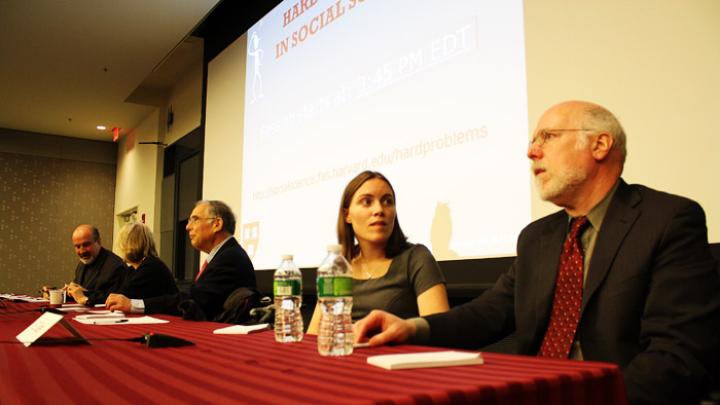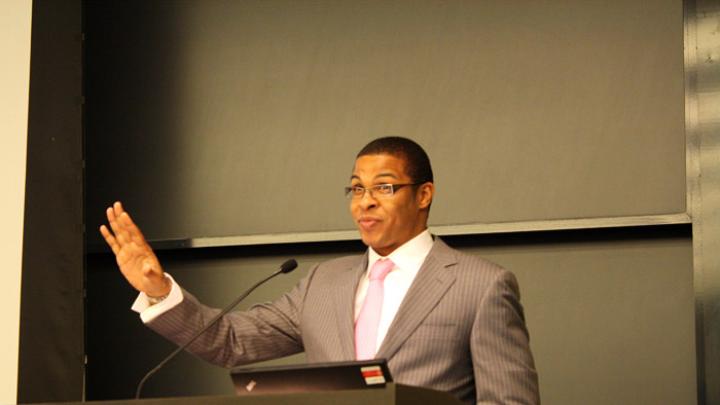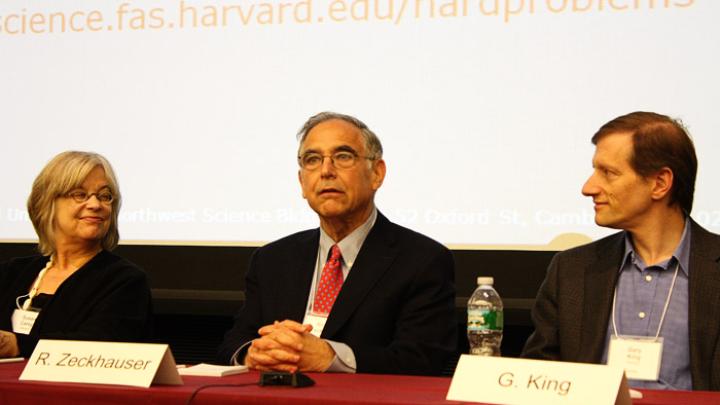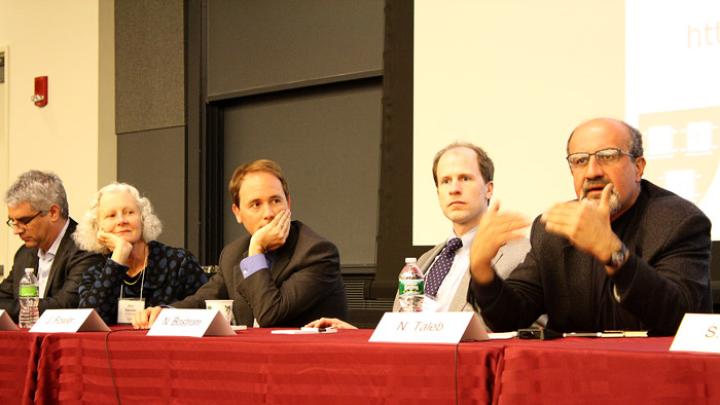Across all the disciplines of the social sciences—economics, history, anthropology, political science, sociology, and more—what are the hardest problems that need solving, and which are most worthy of time spent working on a solution?
Scholars from a range of disciplines presented their answers to this question in an April 10 symposium at Harvard. The discussion continues online, where visitors can rank the presenters’ problems in terms of importance and add their own problems to the list through the end of May.
The symposium, sponsored by the Indira Foundation (a Connecticut-based charitable organization that supports efforts in education, healthcare, and social welfare), was inspired by the work of the German mathematician David Hilbert, who in 1900 posited his own set of 23 hard problems from mathematics (just 10 of which have been fully solved, said Lindsley professor of psychology Stephen M. Kosslyn, dean for social sciences in the Faculty of Arts and Sciences, in his introductory remarks).
The format—each presenter was given 15 minutes to discuss one hard problem or a few; questions were held for the end of the day—invited free-flowing, fast-flying ideas.
Nicholas Christakis, professor of medical sociology and of medicine at Harvard Medical School and professor of sociology in FAS, argued for further exploration of how the social becomes biological. Scholars in the life sciences, and the social sciences as well, have already begun to illuminate some answers, with the field of genetics developing rapidly. But Christakis said he believes that in the years ahead, researchers will be able to say, with more certainty, what evolutionary advantage some attributes bring: why, for example, does emotional contagion exist? Why would it provide a selective advantage if, when you meet someone in a foul mood, it poisons your own mood, too? And how can biology account for behavior—which is not genetically determined, although genes may contribute—with findings such as abusive behavior being transmitted through subsequent generations of rats?
Noting that he and collaborators recently published a study showing that altruism spreads through social networks, Christakis said he believes this line of inquiry will also shed light on the origins of goodness. (Christakis’s work is featured in the article “Networked,” in the magazine’s May-June 2010 issue.)
University of California, Berkeley sociology professor Ann Swidler ’66 highlighted the question of how societies create institutions, and how they restore missing or damaged ones. The American military’s experiences in Iraq and Afghanistan indicate just how little is known about this, she said.
Swidler cautioned that any solutions would be tremendously complicated, given the sheer range of entities and phenomena that qualify as institutions: governments, universities, and marriage, to name a few—and noted a few of the considerations that should come into play: the historical and cultural context of an institution; the power of ritual and symbol.
Nassim Taleb, Distinguished Professor of risk engineering at Polytechnic Institute of New York University and Distinguished Research Scholar at Said Business School, Oxford University, spoke of “the problem of small probability.” Taleb, who was a derivatives trader during the stock market crash of 1987 and is the author of The Black Swan: The Impact of the Highly Improbable (2007), noted that science—whether lab science or social science—cannot account for extremely rare events such as financial meltdowns. Simply because they are so unlikely and occur so rarely, there is no way to incorporate them into mathematical models with any degree of precision. “The smaller the probability, the less you’re observing it in a sample,” said Taleb, “so your error rate is going to be very high.”
Even with the most accurate statistical methods, small differences in calibration can mean big swings in predicted results. “Not only can we not predict rare events,” he said, “but we cannot even figure out what role they play in the data.” That is because "you don’t measure risk like you measure a table,” he said: risk cannot be quantified in a precise way. This problem may not be solvable, Taleb acknowledged; the most to hope for, he said, may be to define its boundaries.
Ford professor of the social sciences Robert J. Sampson delivered a summary of the presentation that Peter Bearman, Ph.D. ’85, Cole professor of the social sciences at Columbia, had intended to give (a family emergency kept him from attending). Bearman, a sociologist, zeroed in on the way academia focuses on change, when what may be more interesting is the continuity of certain aspects of the human experience—our inability to eradicate violence, for instance. “The groups differ,” Sampson summarized, “but the problem endures."
Oxford University philosopher Nick Bostrom challenged the academic community to identify the biggest fallacies that are accepted as common knowledge today, and highlighted past misconceptions that were once universally believed:
- “Thoughts and feelings are meaningless concepts; there are only stimulus-response relationships.”
- “Mental illness is caused by possession by the devil.”
- “Human mind at birth = tabula rasa.”
- “There are no inborn differences in personality or intelligence.”
- “Some races are incapable of higher civilization.”
- “In the state of nature, everyone lives in peace and harmony.”
- “Only exceptionally evil characters would ever abuse those over whom they hold absolute power.”
- “Trade causes economic weakness.”
“Not all progress consists of going forward,” said Bostrom. “Sometimes if we’ve taken a wrong turn, what we need to do is turn back.”
Weatherhead University Professor Gary King, who directs Harvard’s Institute for Quantitative Social Science, posed a methodological problem: “post-treatment bias in big social-science questions.”
Post-treatment bias happens when researchers, in attempting to control for variables that may skew the results of a study, inadvertently control for a variable that is directly related to the outcome they wish to measure, yielding erroneous results.
King gave the example of a company accused of paying black employees less than white employees. When studying whether the accusation is true, a researcher’s natural instinct would be to control for position within the firm, so that the question being asked is whether employees are getting equal pay for equal work. But if 99 percent of employees in the mailroom are black, and 99 percent of employees in upper management are white, it might not matter that all the mailroom employees are paid at the same rate as each other and all the high-level managers are paid at the same rate as each other. “If you control for position in the firm,” said King, then you’ll find that race has “no effect on salary—and then this racist firm gets to say, ‘Hey, no problem!’ ”
King highlighted four pressing real-world questions for which post-treatment bias stands in the way of finding answers:
- Does democratization reduce international conflict?
- Does ethnic diversity in developing countries cause civil war?
- Does trade openness reduce the risk of state failure?
- Do strong international institutions lead to, or result from, international cooperation?
Emily Oster ’02, Ph.D. ’06, focused on behavior change in health. Massive increases in life expectancy during the twentieth century resulted from advances in sanitation, technology, and medicine; in the twenty-first century, she said, they will depend on getting people to change their behavior—an infinitely trickier task.
Oster, an assistant professor of economics at the University of Chicago, noted that newly diagnosed diabetics who are very obese gain more weight, in the year following their diagnosis, than similarly sized people who are not diabetic—contrary to what one might expect, that the diagnosis would lead them to take better care of their health and lose weight. In addition, she noted, only 60 percent of diabetics who are prescribed medication take it as directed.
Over and over, when economics and public-health researchers ask, “Do people do good things for their health if they’re very easy?” the answer turns out to be no, Oster said, pointing to two more examples of the same problem: the difficulty of getting people to stop having unprotected sex, even given how well scientists understand how HIV spreads; and research findings from sub-Saharan Africa showing that when an improved water source is available, but slightly farther away from a person’s home than an unimproved water source, people are unlikely to walk the extra distance to get clean water.
Lee professor of economics Claudia Goldin called for further research on the persistent problem of why women are paid less than men are, and how to level the playing field. Her own research has shown that most or all of this bias is unintentional: women self-select into fields that pay less. For a salaried employee, it would seem that working longer hours would translate into earning less per hour. But, Goldin said, “In some occupations, the more you work, the higher your hourly earnings.” In these fields, she said, employers are willing to pay more for one employee who puts in 70 hours a week than for two who put each put in 35. (Read more about Goldin’s research on gender and career in the Harvard Magazine archives.)
Beren professor of economics Roland Fryer drew attention to another persistent problem in American society: the racial achievement gap in education. This gap, he said, underlies numerous other social problems: racial differences in the incarceration rate, employment, wages, and health.
As a society, Fryer said, Americans have followed the conventional wisdom about improving schools: bringing class size down, raising per-pupil spending, and urging teachers toward master’s degrees and other professional development—but that hasn’t worked.
Instead, Fryer suggests looking at what successful schools do and simply copying it in a widespread fashion. In research that sent camera crews into successful schools looking for patterns (see "Studying Schooling" in the magazine archives), Fryer said four factors came to light:
- human capital: rewarding good performance and holding teachers accountable;
- more time spent in school by students;
- data-driven instruction: not just measuring what students are and aren’t learning, but following up to drill them on, or re-teach, what wasn’t grasped the first time; and
- a school culture that all concerned parties—students, teachers, parents—buy into.
Morss professor of psychology Susan Carey selected a problem of human cognition: “How can you create new knowledge when you don’t even have the resources to represent the knowledge you seek to create?”—and, following on that, how does humankind update its collective understanding of a concept when new knowledge is added?
Carey provided a concrete example: the system of atomic numbers in chemistry and physics was not developed until the nineteenth century, and not fine-tuned until the twentieth, but people knew about the element gold, and had a conception of what gold was, long before that.
Many of the problems raised at the symposium, she said, “are problems where we don’t really know how to think about the question."
James Fowler ’92, Ph.D. ’03, called for the development of methods to explain clustering in social networks. Fowler, a political scientist at the University of California-San Diego, noted that clustering is observable for a number of attributes—be it innocuous phenomena like music tastes, or attributes with more serious implications, such as obesity or alcoholism—but current social-science methods aren’t sufficient to separate homophily (people’s tendency to choose friends like themselves) from influence (friends adopting behaviors from other friends in cause-and-effect fashion).
“If it’s just people forming friendships with one another,” Fowler noted, “that gives you a very different policy prescription than if one person’s influencing another person.” (He and Christakis have begun to tackle this problem in their own work; see “Networked” from the magazine’s May-June issue.)
Ramsey professor of political economy Richard Zeckhauser discussed the difficulty in engineering systems (political and otherwise) that balance the preferences of their constituents. Different individuals may have vastly different goals; even if they have the same goals, they may disagree about how to reach them. Simple majority rule can act to disenfranchise some group members, but a compromise may leave nobody satisfied. No perfect solution has yet been found, said Zeckhauser, whose own research has examined how to target government spending precisely to benefit those who stand to gain the most from it, among many other topics. “I hope we get there in 10 years,” he said, but, “progress will come by chipping away. It won’t be some giant Eureka!”
although each presenter supposedly outlined what he or she saw as the most pressing problems in the social sciences today, an audience inquiry about what other questions the panel would have raised, having heard each other's contributions, prompted the formation of a whole new list.
“I’m glad that we were given this opportunity,” Goldin responded, “because when we were asked to come up with a hard problem in the social sciences, I think all of us thought very hard about it, and we came up with a bunch of hard problems. But when we had to create something for the audience, we realized that we had to come up with something that we actually knew something about, so then we threw away that hard problem and we took our research.”
She added that the problem she really wanted to talk about was how and why social norms change. Other presenters added these problems to the mix:
- the problem of emergence: “How do you get the mind out of a bunch of neurons? How do you get a political system or an economic system out of a bunch of individual people?” (Kosslyn)
- the role for genetics in thinking about social-science problems (Oster)
- how, in general, to jump from breakthroughs on small problems to progress on big problems: “We’re better at biology than behavior.” Obesity, from a biologist’s point of view, is “totally solved,” said King—people just need to exercise more and eat less. But as Oster noted, getting people to do these things is easier said than done, and so from the point of view of economics and psychology, the problem is “not solved at all.”
- how to square the realization that people don’t always behave rationally with the need to avoid paternalism and let people make their own decisions even when they choose an outcome that isn’t good for them (Zeckhauser)
- trying to understand ideologies—“the beliefs we have that we’re willing to die for” (Carey)
- the “translational gap”—the gap between advances in knowledge and their implementation. “You go to business school and take a class in finance, and they teach you theory that we know doesn’t work, that we have known doesn’t work now for 25 years,” said Taleb. But “people still teach it today.”
- how to explain “small outbursts of creativity and achievement”: such Renaissance Florence, the Scottish Enlightenment, Silicon Valley. “What enabled small populations to achieve disproportionately for a period of time?” Bostrom asked. “Is that something we could learn to recreate deliberately?”
- the evolutionary origin of overconfidence. Citing a study that showed that 94 percent of academics think their work was above average, Fowler said, “We have this ‘Lake Wobegon effect’ that really interests me.”
- developing better models of what culture is and how it works. “It’s really important to remember,” said Swidler, “that you cannot derive the properties of a complex arrangement from the properties of the individual pieces.”
- the question of where tastes come from. “If your tastes come from the people around you,” asked Christakis, “where do their tastes come from? Maybe all of a sudden one person wants something for a chance reason, and it just ripples through the network.”
To read more about the symposium, see accounts from the Harvard Crimson, the opinion pages of the Wall Street Journal, and on the HarvardScience and Alumni Affairs & Development websites.










